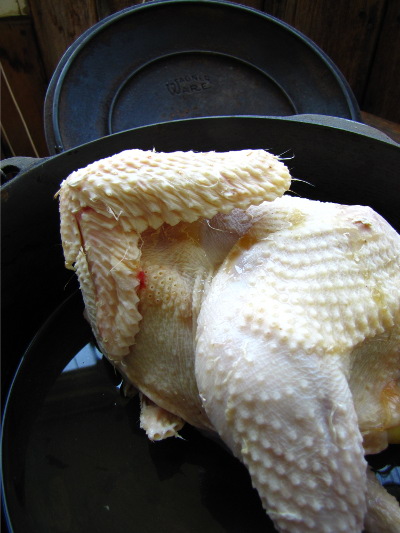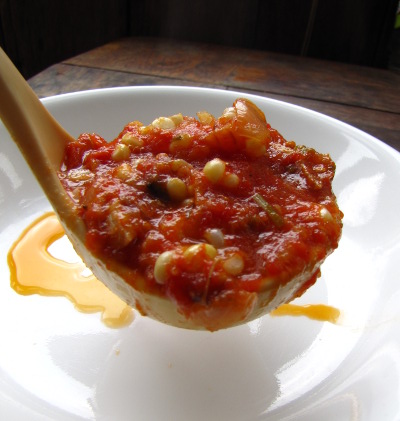
Traditional way to cook an old chicken
 I've posted before about ways
to cook an old chicken:
I've posted before about ways
to cook an old chicken:
Stew
it for eight hours.
Cut
the raw meat off the bones and grind it for use in potstickers,
sausage, etc.
Both of those methods
work (especially the second one), but I recently discovered that
neither is the traditional way to turn that hen who no longer lays well
into dinner. It turns out that old chickens were actually
preferred by many cooks until recently since chickens over a year old
have more flavor. These chickens were sold as "fowl" or "stewing
chickens" and were used to create chicken soup, chicken stock, chicken
salad, and chicken pot pies.
Both of the methods I've
used to cook old chickens in the past break apart the tough, stringy
fibers that inevitably form if you cook a fowl in boiling water, but
you can prevent these fibers from forming in the first place by using
moist heat that never raises the temperature of the chicken above 180
degrees Fahrenheit. I tried out two methods, my favorite of which
was to put two cups of water in the bottom of a Dutch
oven (or other
covered roaster) and bake at 325 degrees Fahrenheit.
Alternatively, you can get the same effect by cooking your chicken in a
covered pot on the stove as long as you make sure the water never
boils, but I thought it was more difficult to keep the liquid at a
simmer in that situation. Crock pots are reputed to raise the
temperature too high.
 Either way, you'll want to
cook your fowl about an hour per pound, removing the white meat as soon
as it's done and then stewing the rest of the chicken a bit
longer. Cooked in this manner, the meat will only be a tiny bit
tougher than meat from a grocery store chicken --- chance are, no one
will notice if you don't tell them.
Either way, you'll want to
cook your fowl about an hour per pound, removing the white meat as soon
as it's done and then stewing the rest of the chicken a bit
longer. Cooked in this manner, the meat will only be a tiny bit
tougher than meat from a grocery store chicken --- chance are, no one
will notice if you don't tell them.
I consider chicken stock
to be the most efficient use of a chicken, especially at this time of
year when I'm turning my garden into soup for the winter as fast as I
can. To make the stock, I removed the breast after two hours,
then added more water and simmered the carcass for a few more hours
until it was easy to peel all of the meat from the bones. Then I
tossed the stock and meat back in the pot with all of the fixings for harvest
catch-all soup.
One old chicken made a gallon and a half of condensed chicken and
vegetable soup, enough for two dozen winter meals. Now that's a
good use of an old chicken!
Want more in-depth information? Browse through our books.
Or explore more posts by date or by subject.
About us: Anna Hess and Mark Hamilton spent over a decade living self-sufficiently in the mountains of Virginia before moving north to start over from scratch in the foothills of Ohio. They've experimented with permaculture, no-till gardening, trailersteading, home-based microbusinesses and much more, writing about their adventures in both blogs and books.
Want to be notified when new comments are posted on this page? Click on the RSS button after you add a comment to subscribe to the comment feed, or simply check the box beside "email replies to me" while writing your comment.


Sounds like a sous-vide would cook them well. Or a makeshift sous-vide, creating by rigging a temperature controller to a slow cooker :-).
Actually, thinking some more, a haybox cooker might do this really well. You get the pot up to boiling, then put it in an insulated box to finish cooking. The temperature would stay under the boiling point that way.